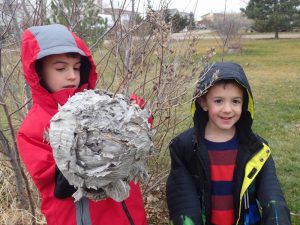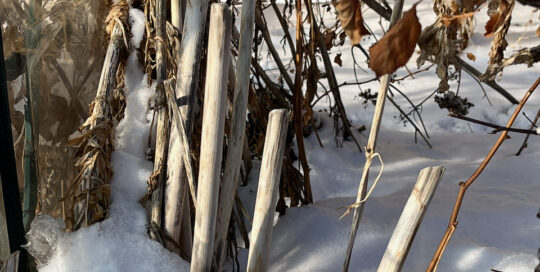Peering Inside the Hornet’s Nest
Views: 6330

Yellow jackets and hornets were horrible this past summer. Truthfully, they were so bad that our eldest recently said that he dreads the time from June to August because of them. Since I live for the summer (minus the hornet’s nest), that’s not something I want to hear!
Hornet’s Nest in the Lilac Bush
You can imagine my surprise when I noticed a large nest in the small lilac bush at the corner of our neighbor’s property once the leaves came off of the trees this fall. No wonder they were so bad at our place. The papery nest, which was nearly a foot in diameter, was home to either the aerial yellow jacket (Dolichovespula aranaria) or the bald-faced hornet (Dolichovespula maculata). Regardless of the species, this was a bad place for a large nest.
The general lifecycle for both species is the mated queen will find a safe place to overwinter, while all of the other bees will die with the freezing temperatures. According to entomologists, they don’t reuse the nests. Once I was able to grab my neighbor to ask her if we could cut out the nest, I snipped it out of the small lilac bush so we could examine it closer. I even cut it in half yesterday because several people told me the yellow jackets or hornets were hibernating. I hated to do it because I wanted to keep it for the boys, but curiosity got the best of me. It was empty. Now I want to find another.
The nest itself is a pretty amazing creation. It’s really beautiful. There are layers of the paper-like material that cover the “floors” of comb. It looks like it would need an elevator in the middle to access each of the sections. Of course, this would never hold the same amount of bees in a honey bee hive, but I’m guessing there would easily be hundreds of bees inside during the peak of the summer. It boggles my mind as to how they can build this during a single season, then just leave it for the weather to destroy.
Trapping Mated Female Bees
It’s a good thing this nest location for the bees is history because it was a source of bees near where we liked to eat dinner, but it reminds me that I have to be particularly vigilant about trying to capture as many mated females as possible early in the spring. They are out there, tucked in somewhere that the freezing temperatures won’t bother them. And when it starts to warm up, those females will be out feeding, and will find a new place to build a nest. That’s when I need to have the pheromone baited traps out to lure them in and eliminate them before they hatch in droves.
And, even beyond what I can do with the traps, I can hope for some freezing temperatures in the spring. I can’t believe I just said that! But looking back over the spring, we didn’t have a significant cold event (below 20 degrees F.) pretty much from early April. That means the females got that much of a jump to make more yellow jackets and hornets, which is one reason they were so prevalent this season. I hate to admit it, but I guess there are some good parts of the cold. And reducing the number of flying, stinging insects is definitely one of them.
Meet Amy Grisak
Amy is a freelance author and photographer in Great Falls, MT who specializes in gardening, foods, and sustainable agriculture. She provides information on every kind…
Amy's Recent Posts

This Little Piggy is a Problem: Dealing with Feral Hogs








